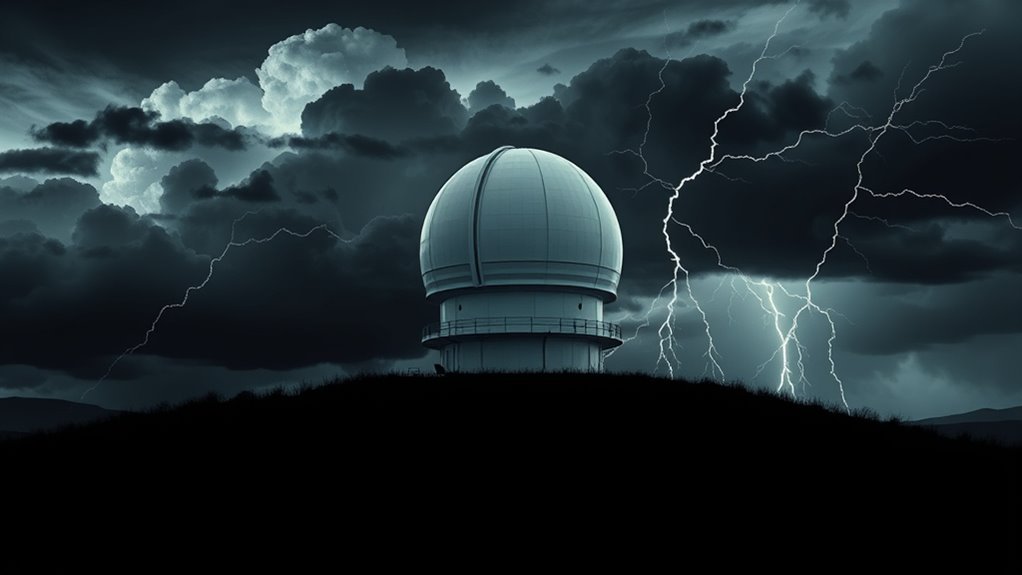Atmospheric science is instrumental in comprehending squall dynamics, defined by rapid wind increases and precipitation. It examines temperature gradients and humidity to predict squall formation. Understanding wind patterns and their role in localized updrafts and downdrafts is essential. Advanced technologies, like remote sensing and computational modeling, improve forecasting accuracy. Accurate forecasts mitigate impacts on aviation and maritime operations, ensuring safety and efficiency. More understanding into squall dynamics and their consequences await exploration.
Main Points
- Atmospheric science provides insights into the temperature and humidity interactions that trigger squall formation and intensity.
- Understanding wind shear and its role in squall dynamics helps improve forecasting and prediction models.
- Remote sensing technologies, like radar and satellite imagery, are essential for real-time monitoring of squall conditions.
- Computational modeling simulates atmospheric processes, enhancing the understanding of squall behavior and impacts.
- Ongoing research in atmospheric science focuses on the effects of climate change on squall frequency and severity, informing preparedness strategies.
What Are Squalls and Their Characteristics?
Squalls are intense bursts of wind and precipitation that can occur suddenly within a storm system. These meteorological phenomena are defined by a rapid increase in wind speed, often exceeding 30 knots, accompanied by heavy rainfall or snow.
Squalls typically form along cold fronts or within thunderstorms, where contrasting air masses interact. The duration of a squall is usually brief, often lasting only a few minutes to an hour, yet they can cause notable disruptions.
Their unpredictable nature makes squalls hazardous, particularly for maritime activities and aviation. Visibility can drop dramatically during a squall, and the sudden wind changes can challenge even experienced sailors and pilots.
Additionally, squalls can trigger localized flooding and create dangerous road conditions. Understanding the features of squalls is essential for effective forecasting and public safety, as their sudden onset can leave little time for preparation or evacuation.
The Importance of Temperature and Humidity in Squall Formation

Temperature gradients and humidity levels play vital roles in the formation of squalls.
Variations in temperature can create instability in the atmosphere, while adequate humidity supports the development of convective processes.
Understanding these factors is essential for predicting squall dynamics and their associated impacts.
Temperature Gradients Impact
How do temperature gradients influence the dynamics of squall formation?
Temperature gradients play a critical role in the development of squalls by creating instability in the atmospheric layers. When warm, moist air at the surface rises and encounters cooler air aloft, it leads to rapid convection. This upward movement can generate strong updrafts, which are essential for squall formation.
Additionally, steep temperature gradients can improve wind shear, thereby intensifying the horizontal and vertical wind patterns. As a result, these conditions contribute to the development of severe weather phenomena, such as thunderstorms, associated with squalls.
Understanding temperature gradients helps meteorologists predict the onset and intensity of squalls, eventually aiding in effective weather forecasting and public safety measures.
Humidity's Role in Instability
Instability in the atmosphere is greatly influenced by humidity levels, which play an essential role in squall formation. High humidity boosts the buoyancy of air parcels, allowing them to rise more readily. This upward motion is critical in generating convective activity, leading to the development of thunderstorms associated with squalls.
When moist air rises, it cools and condenses, releasing latent heat that further fuels convection. Conversely, low humidity can suppress this process, resulting in less intense squall activity.
The interaction between humidity and temperature creates conditions conducive to instability, making it a crucial factor in forecasting squall events. Understanding these dynamics enables meteorologists to predict severe weather more accurately, finally improving public safety and preparedness.
Wind Patterns: Key Factors in Squall Dynamics
While various meteorological elements contribute to the formation of squalls, wind patterns play a vital role in shaping their dynamics. The interaction between different wind layers can lead to the development of strong, localized updrafts and downdrafts, which are fundamental for squall formation.
These wind patterns are influenced by a variety of factors, including temperature gradients, topography, and the presence of frontal systems.
In particular, horizontal wind shear—variations in wind speed and direction at different altitudes—can improve the intensity and organization of squalls. When warm, moist air rises rapidly in the presence of cooler air, the resulting convergence can trigger severe weather phenomena.
Additionally, the influence of local terrain can create complex wind patterns that further modify squall behavior. Understanding these wind dynamics is significant for predicting squall intensity and associated weather hazards, eventually aiding in more effective forecasting and public safety measures.
Advanced Technologies in Atmospheric Research

Advanced technologies play a significant role in atmospheric research, particularly in understanding squall dynamics.
Remote sensing techniques provide important data on atmospheric conditions, while computational modeling approaches enable researchers to simulate and predict squall behavior more accurately.
Together, these tools improve the ability to analyze complex weather patterns and enhance forecasting efforts.
Remote Sensing Techniques
As researchers seek to improve their understanding of atmospheric phenomena, remote sensing techniques have emerged as essential tools in atmospheric science.
These groundbreaking methods allow scientists to gather critical data from afar, enhancing their ability to monitor and analyze squall dynamics. Remote sensing provides observations that are often unattainable through traditional observational methods.
- Satellite Imagery: Captures large-scale atmospheric patterns and storm development.
- Lidar Systems: Measure atmospheric properties with high spatial resolution, aiding in the detection of wind profiles.
- Radar Technology: Offers real-time tracking of precipitation and storm intensity.
Together, these techniques enable a more thorough understanding of squall events, ultimately contributing to improved forecasting and mitigation strategies in atmospheric science.
Computational Modeling Approaches
Computational modeling approaches play an essential role in enhancing the understanding of squall dynamics by simulating complex atmospheric processes. These models incorporate various physical principles, including fluid dynamics and thermodynamics, to replicate the conditions that lead to squall formation and evolution.
High-resolution numerical simulations allow researchers to analyze the interactions between different atmospheric layers and the influence of environmental factors, such as temperature and humidity gradients. Advanced techniques, such as large eddy simulations and ensemble forecasting, provide revelations into the variability and predictability of squall events.
The Role of Numerical Weather Prediction Models

Numerical Weather Prediction (NWP) models play an essential role in the forecasting of atmospheric phenomena, particularly in the dynamics of squalls.
These models, driven by mathematical equations that describe atmospheric processes, enable meteorologists to simulate and predict the development and movement of squall lines with greater accuracy.
Key benefits of NWP models in squall prediction include:
- Enhanced Forecast Accuracy: Advanced algorithms assimilate extensive amounts of observational data, improving the reliability of predictions.
- Real-Time Monitoring: NWP models provide continuous updates, allowing for timely alerts regarding squall formation and intensity.
- Improved Understanding of Dynamics: These models aid the analysis of complex interactions within squall systems, contributing to a deeper understanding of their behavior.
Impact of Squalls on Aviation and Maritime Operations
Squalls can considerably disrupt aviation and maritime operations, posing serious risks to safety and efficiency.
In aviation, sudden wind shifts, intense turbulence, and reduced visibility associated with squalls can lead to challenges during takeoff and landing. Pilots must often alter flight paths or delay departures, resulting in increased operational costs and passenger inconvenience. Additionally, squalls can greatly impact air traffic control, requiring timely communication and coordination to guarantee safety.
In maritime contexts, squalls can generate hazardous conditions for vessels, including steep waves and sudden changes in wind direction. These factors can complicate navigation and increase the risk of capsizing or collisions.
Furthermore, squalls may force ships to seek shelter, disrupting schedules and supply chains. Ultimately, understanding the dynamics of squalls is essential for mitigating their adverse effects on both aviation and maritime operations, highlighting the importance of accurate forecasting and timely response measures.
Future Directions in Squall Research and Forecasting
As advancements in technology and meteorological science continue to evolve, the future of squall research and forecasting looks promising. Researchers are increasingly focusing on integrating high-resolution models with real-time observational data to improve predictive capabilities. This shift may lead to more accurate and timely warnings, eventually minimizing the impact of squalls on various sectors.
Key areas of future exploration include:
- Improved Remote Sensing: Utilizing advanced satellite and radar technology to monitor squall formation and development in real-time.
- Machine Learning Applications: Implementing AI-driven algorithms to analyze historical squall data and identify patterns that could enhance forecasting accuracy.
- Climate Change Impacts: Studying how ongoing climatic shifts may influence the frequency and intensity of squalls, aiding in long-term preparedness strategies.
With these developments, the meteorological community is poised to greatly advance squall forecasting methodologies, improving safety and operational efficiency.
Common Questions
How Do Squalls Differ From Thunderstorms or Hurricanes?
Squalls are brief, intense wind events often accompanied by precipitation, differing from thunderstorms, which involve lightning and thunder, and hurricanes, defined by sustained winds and a larger scale. Each weather phenomenon exhibits distinct formation and impact characteristics.
Can Squalls Occur in Winter as Well?
Squalls can occur in winter, often marked by sudden and intense winds accompanied by snow or rain. These winter squalls may lead to reduced visibility and hazardous driving conditions, similar to their summer counterparts.
What Role Does Topography Play in Squall Development?
Topography greatly influences squall development by affecting wind patterns, moisture distribution, and temperature variations. Mountains can improve lift, while valleys may channel winds, creating localized conditions that either encourage or inhibit squall formation and intensity.
How Can Squalls Affect Local Ecosystems?
Squalls can considerably impact local ecosystems by altering rainfall patterns, which affects soil moisture and plant growth. Additionally, strong winds may disrupt wildlife habitats, influencing animal behavior and migration, ultimately reshaping the ecological balance in affected areas.
Are There Historical Case Studies of Notable Squalls?
Historical case studies of notable squalls include the 1954 hurricane squall in Florida and the 1983 squall line in the Midwest, both of which caused considerable damage and provided important perspectives into severe weather patterns and impacts.

